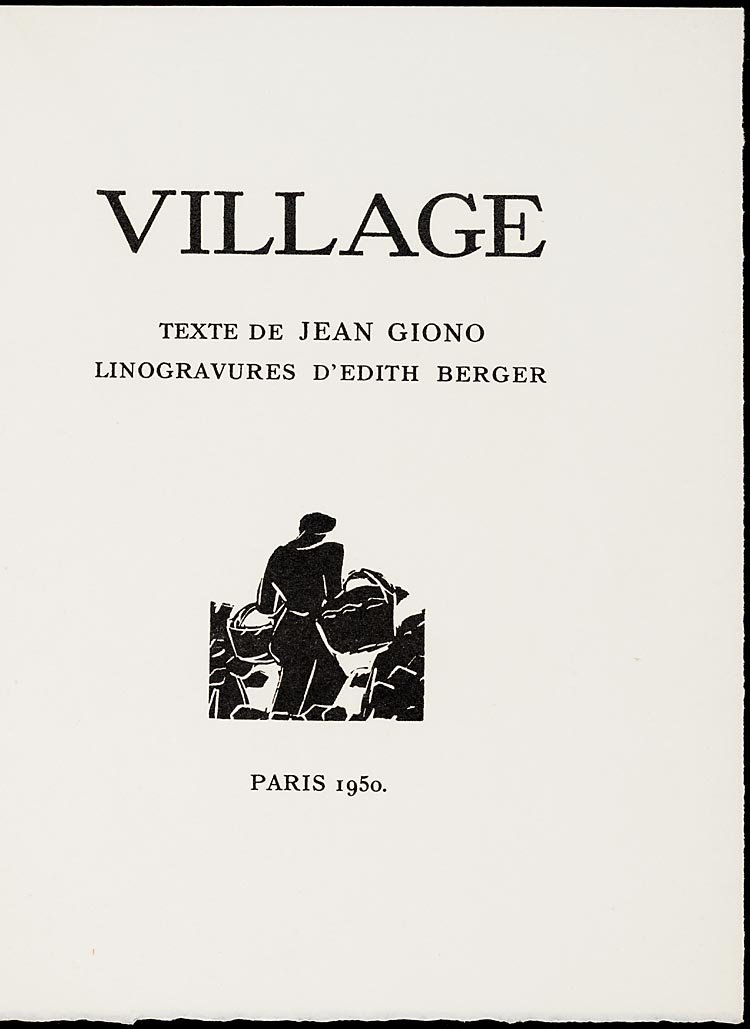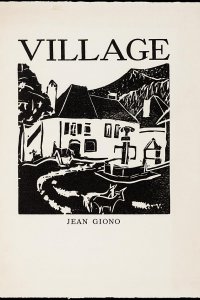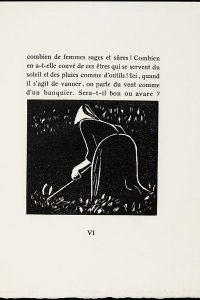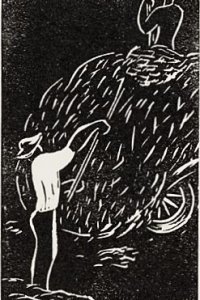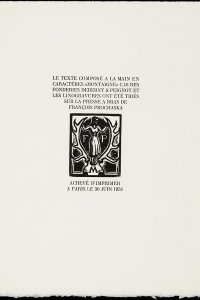Village
Year: 1950
Author: Jean Giono (1895 - 1970)
Artist: Edith Berger (1900 - 1994)
Publisher: François Prochaska
Giono wrote about the simplicity and naturalness of country life. The two main enemies of modern man were city life and intelligence, according to Giono. Opposite them stood our natural allies: landscape and intuition, animals and ancient traditions. He hoped that farmers would revolt against the modernisation of life: but in his own story (Village), they fail to take any such action. 'When he is talking about a good or bad character, you can assume that he is talking about animals, not about people'. Another quote from the book is: 'Progress with its electricity (not a word about that!), what can this do with a sheep but turn it into cutlets?'
Linocuts
From 1946 onwards Giono returned to Lalley again every year. Édith Berger created a series of linocuts for Village, after which Giono added his introduction. The luscious beauty of the landscape is not all that obvious in these linocuts. They are simple presentations, printed in black-and-white, that bring to mind the rustic scenes of the impressionists, like Camille Pissarro. For another book by Giono (Les vraies richesses) photographer Gerull Kardas took 112 black-and-white photographs, which therefore also lack the colour of the landscape. The photographs, just like Berger's linocuts, do however give a good impression of the quiet world in which a reposing deer, a farmer with a hoe, labour around a hay wagon, or a silent snowy landscape have been captured. A reprint of Village appeared in 1985, without the linocuts, but with pencil drawings and pastels by Berger, which provide a more dynamic, more colourful and therefore livelier impression of the Trèves area.
The first edition was printed in June 1950 by François Prochaska in a limited edition of 150 copies. The Koopman Collection contains number 75, printed on vélin d'Arches. Prochaska (probably born in Sanak, Poland) owned a hand-operated press, using an appropriate font for the typesetting: the Montaigne (or: Mountain). Besides his initials, his printer's emblem includes a set of antlers, between which a female figure is standing with her arms spread out. He also illustrated books himself (in 1954 for instance A. T'Serstevens' Intimité de l'Ile Saint Louis, which he also published). Édith Berger created a linocut for nearly each page in Village, with a total number of 25.
Bibliographical description
Description: Village / texte de Jean Giono ; linograv. d'Edith Berger. - Paris : [François Prochaska], 1950. - xxv p. : ill. ; 31 cm
Printer: François Prochaska (Paris)
Edition: 150 copies
This copy: Number 75 of 150 on Arches
Typeface: Montaigne
Bibliography: Monod-5423
Shelfmark: KW Koopm A 304
References
- Pierre Citron, Giono 1895-1970. Paris, Éditions du Seuil, 1990
- Gaïté Dugnat, Pierre Sanchez, Dictionnaire des graveurs, illustrateurs et affichistes français et étrangers (1673-1950), Tome 4: Leq-P. Dijon, Echelle de Jacob, 2001
- Jean Giono, Village.Lyon, La Manufacture, 1985
- Pierre Magnan, La Provence de Giono. Paris, Éditions du Chêne, 2000
- Denis Labouret, Les grands chemins de Giono ou Les détours du temps. Paris, Belin, 2000
